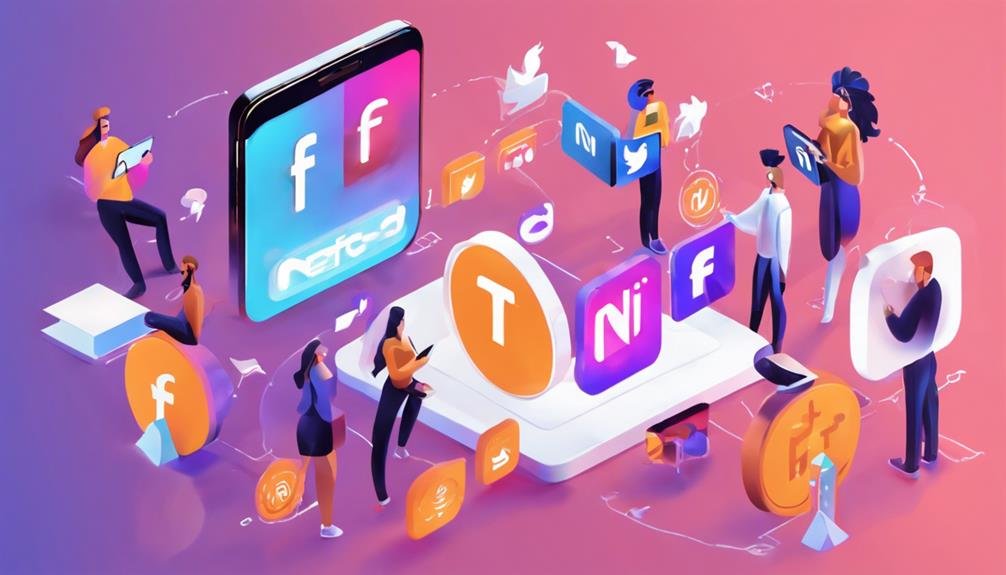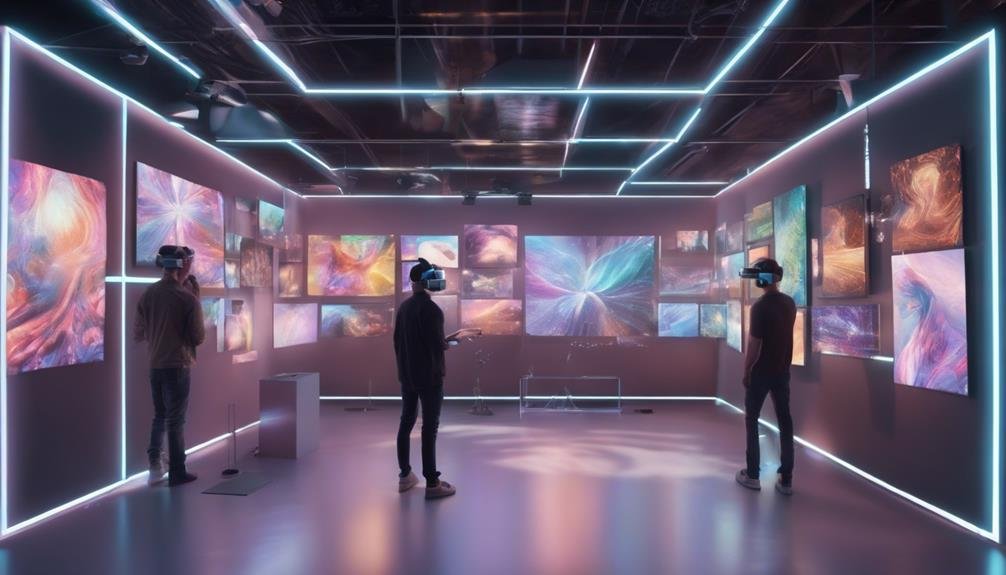To master NFT market trends and understand digital art’s rising sales and revenue streams. Platforms like SuperRare and Foundation curate art NFTs, impacting trends. NFT collectibles stress rarity, scarcity, and historical significance, influencing market dynamics. Virtual land scarcity shifts digital ownership, with surging prices and DAO governance reshaping trends. Interoperability enhances liquidity and connects ecosystems, allowing broader participation. Sustainability issues drive eco-friendly blockchain adoption and ethical practices. Embrace unique ownership, provenance, and scarcity for NFT growth. User engagement, smart contracts, and evolving ecosystems guide NFT market changes. Explore these insights for a detailed view of NFT trends.
Table of Contents
Brief Overview of 10 Key Insights: Analyzing Trends In NFT Markets
- Understand digital art influence for revenue opportunities.
- Focus on rarity, scarcity, and cultural significance in collectibles.
- Monitor virtual land scarcity and investment potential.
- Embrace interoperability for liquidity and collaboration.
- Address sustainability concerns for ethical NFT practices.
Digital Art Influence
Digital art has dramatically shaped the NFT market landscape, with sales soaring to $2.5 billion in the first half of 2021. The rise of digital art NFTs has provided artists with new revenue streams and ownership opportunities, disrupting the traditional art market landscape. Platforms like SuperRare and Foundation have played a pivotal role in curating and selling digital art NFTs, attracting a growing community of art enthusiasts and collectors.
In 2020, NFT art sales witnessed a remarkable 704% increase, signaling the surging interest and demand for digital art within the NFT space. Artists like Beeple have capitalized on this trend, selling digital art NFTs for millions and showcasing the transformative potential of NFTs for creators in the art world. This evolution has revolutionized how art is bought and sold and opened up new possibilities for artists to showcase their work and engage with a global audience in unprecedented ways.
Collectibles Market Dynamics

The NFT collectibles market dynamics showcase a fascinating interplay of rarity, scarcity, and cultural significance. Within this market, unique digital assets such as art pieces, virtual real estate, and in-game items are actively traded and collected. The value and appeal of NFT collectibles are often heightened by their limited editions or distinctive attributes, emphasizing the importance of rarity and scarcity in this space.
Factors like artist reputation, historical sales data, and cultural significance are vital in shaping trends in NFT collectibles. Understanding the intricate balance between these elements is essential to successfully maneuvering this evolving landscape. As collectors and traders continue to engage with NFTs, staying informed about these market dynamics will be vital in making informed decisions and capitalizing on emerging opportunities within the collectibles sector.
Virtual Real Estate Trends

Virtual real estate NFTs present a unique blend of challenges and opportunities. Land scarcity in virtual worlds challenges users seeking prime locations for development. However, with the expanding metaverse, there are abundant opportunities for creative and immersive experiences that could revolutionize the virtual real estate market.
Land Scarcity Challenges
Traversing the dynamic landscape of NFTs, you encounter a significant obstacle: the escalating scarcity of virtual land. Virtual real estate scarcity challenges are reshaping the digital ownership landscape, pushing prices to unprecedented levels, with some virtual lands fetching millions of dollars. The limited availability of prime virtual locations intensifies competition among investors and developers seeking lucrative investment opportunities within metaverses.
NFT marketplaces are witnessing a surge in virtual land sales, underscoring the increasing value of digital properties in virtual worlds. Innovations like decentralized autonomous organizations (DAOs) are revolutionizing the governance and development of virtual real estate projects, offering new avenues for community participation in shaping the future of virtual landscapes.
Metaverse Expansion Opportunities
Amidst the evolving landscape of NFTs, one encounters a burgeoning domain of opportunity in the metaverse expansion trends of virtual territory. Virtual property sales in the metaverse hit $100 million in 2021, highlighting the trend of digital land ownership. Decentraland‘s $100 million virtual property sales underscore the lucrative opportunities in the metaverse.
Investment prospects abound in metaverse expansion, with virtual territory appreciating as digital ecosystems evolve. Republic Territory’s significant investments in virtual property signal the rising interest and capital flowing into the metaverse. Virtual land transactions are on the rise, with virtual land emerging as a sought-after asset for investors and developers, showcasing the potential for virtual land appreciation.
Interoperability Impact

Embracing interoperability within NFT marketplaces greatly amplifies the fluidity and accessibility of transactions. Here are some key insights to help you understand the impact of interoperability in the NFT market:
- Enhanced Liquidity: Cross-chain compatibility allows NFT assets to move seamlessly between blockchain networks, increasing market liquidity.
- Expanded Reach: Interoperability fosters collaboration among diverse ecosystems within the NFT space, driving innovation and growth by connecting previously isolated platforms.
- Attracting a Broader User Base: NFT marketplaces that embrace interoperability features attract a more extensive user base by catering to various blockchain preferences and making engaging with different tokens easier.
- Facilitating Integration: Standards like ERC-1155 enable interoperability by supporting multiple token types within a single contract and streamlining transactions and interactions across different networks.
Sustainability Concerns

When considering sustainability concerns in the NFT market, analyzing the environmental impact and ethical sourcing practices associated with blockchain technologies is essential. Addressing these factors can lead to the adoption of eco-friendly alternatives and a reduction in the carbon footprint linked to NFT transactions. As the industry shifts towards greener solutions, prioritizing sustainable practices becomes imperative for fostering a more environmentally conscious marketplace.
Environmental Impact Analysis
In pursuing sustainable practices, the NFT market actively explores energy-efficient blockchain alternatives to minimize environmental impact. Here are some key insights to keep in mind:
- NFT marketplaces are increasingly focusing on sustainability concerns, with a shift towards eco-friendly blockchain alternatives.
- Energy-efficient blockchains are being explored to lessen the environmental impact of NFT transactions.
- Environmental sustainability is becoming a key aspect in NFT marketplace development to address growing concerns.
- Implementing eco-friendly practices and technologies is essential for enhancing the long-term viability of NFT ecosystems.
Ethical Sourcing Practices
To understand the ethical sourcing practices in NFT marketplaces, consider the shift towards reducing environmental impact and promoting sustainability in digital asset creation. The increasing focus on sustainability leads to using environmentally friendly blockchain alternatives and energy-efficient protocols. Initiatives to offset carbon footprints associated with NFT transactions are gaining traction to address environmental challenges.
Transparent supply chains and accountability in sourcing materials for NFTs are crucial to guarantee ethical practices. Community pressure and awareness regarding sustainable sourcing are shaping the development of ethical standards in the NFT industry. By embracing sustainable sourcing practices and supporting eco-friendly initiatives, the NFT market can move towards a more moral and environmentally conscious future, meeting the demands of both creators and consumers alike.
Social Media Influence

Social media platforms like Twitter, Instagram, and TikTok are potent tools for promoting and popularizing NFTs. Here are some critical insights into how social media influences the NFT market:
- Influencers and celebrities: Leveraging their massive followings, influencers, and celebrities utilize social media to showcase and sell NFTs to a broad audience.
- NFT drops: Announcements of NFT drops create excitement and engagement on social media, driving interest in these digital collectibles.
- NFT communities: Thriving on platforms like Discord, NFT communities facilitate discussions, collaborations, and trading opportunities, further expanding the reach of NFTs.
- Social media campaigns & collaborations: Collaborations between influencers, NFT artists, and brands through social media campaigns contribute notably to the growth and visibility of the NFT market.
Understanding social media’s influence in the NFT space is essential for maneuvering the evolving landscape and staying informed about market trends and opportunities.
NFT Adoption Factors

When examining NFT adoption factors, analyzing the growth drivers behind the market surge is essential. Market demand analysis is pivotal in understanding why NFTs are gaining traction among various industries. By addressing adoption challenges head-on, the NFT ecosystem can continue to expand and evolve in response to market dynamics.
NFT Growth Drivers
With the increasing digitalization and burgeoning interest in blockchain technology, NFT adoption has seen significant growth across various industries. Here are some key drivers fueling this expansion:
- Unique Ownership: NFTs enable individuals to have verifiable ownership of digital assets, fostering a sense of exclusivity and authenticity.
- Provenance Tracking: Tracking virtual assets’ history and origin through blockchain technology enhances trust and value in NFTs.
- Scarcity: The limited supply of certain NFTs increases their desirability, driving demand among collectors and investors.
- Interoperability: NFTs’ compatibility with different platforms and ecosystems allows for seamless transfer and use, expanding their utility and appeal.
Market Demand Analysis
Market demand for NFTs continues to surge, driven by scarcity, provenance, and uniqueness, attracting collectors and investors alike. The global NFT market is projected to reach $27.1 billion by 2027, highlighting the growing interest in digital asset ownership. The appeal of NFTs lies in their limited availability, traceable history, and one-of-a-kind nature, making them desirable investments.
Brands, celebrities, and artists increasingly explore NFTs for digital ownership and monetization opportunities, further fueling market demand. The accessibility of blockchain technology guarantees secure and transparent transactions, supporting the rising adoption of NFTs. Additionally, the trend of tokenization in various industries like art, gaming, and real estate plays a vital role in driving the demand for NFTs.
Adoption Challenges Addressed
Addressing NFT adoption challenges involves implementing solutions that enhance scalability, speed, and interoperability in blockchain integration. Here are four key factors driving the resolution of these challenges:
- Improved scalability and speed optimization in blockchain integration.
- Interoperability enhancements are facilitating ecosystem growth in NFT marketplaces.
- Decentralized identity solutions enhance user experience and trust for NFT adoption.
- Sustainable NFT initiatives are gaining traction as critical factors in addressing adoption challenges.
Market Dynamics Evolution

The evolution of NFT market dynamics reflects a dynamic interplay of technological advancements and shifting consumer preferences. User behavior, regulatory developments, and technological advancements are pivotal in shaping the NFT market landscape. Innovations like fractionalized ownership, gamification elements, and metaverse integration have revolutionized how NFTs are perceived and traded.
These changes have not only attracted more participants to the market but have also diversified the types of NFTs available. To succeed in this evolving landscape, understanding the competitive dynamics of NFT marketplaces is essential. Exploring the complexities of the market requires a keen awareness of emerging trends and a proactive approach to leveraging them for strategic advantage. By staying informed and adapting to the shifting dynamics, participants can position themselves more effectively in the competitive NFT space, maximizing their opportunities for success.
Technology and Creativity Intersection

How do NFTs revolutionize the fusion of technology and creativity through blockchain tokenization? NFTs intersect these domains by digitizing unique assets on the blockchain, creating new opportunities for artists and collectors alike. Here are four key aspects to ponder in this intersection:
- Secure Ownership: Smart contracts automate NFT transactions, ensuring secure ownership and seamless digital asset transfer.
- Creative Works: Creators leverage NFTs to monetize their digital art, music, videos, and other creative works, providing a new revenue stream and recognition for their talent.
- User Experience: NFT marketplaces offer a platform for artists to showcase and sell their unique creations, enhancing the overall user experience and accessibility for creators and buyers.
- Emerging Trends: The intersection of technology and creativity in NFTs drives emerging trends in blockchain solutions, shaping the future of digital ownership and expression.
Rapidly Changing Ecosystem

Traversing the dynamic terrain of the NFT market requires adaptability and a keen awareness of emerging trends. The NFT marketplace landscape is evolving rapidly, driven by the adoption of smart contracts and the increasing demand to trade digital assets. User engagement shapes the digital landscape as the NFT ecosystem expands. Creators, artists, and collectors actively participate in NFT marketplaces to securely exchange unique digital assets.
The emergence of new trends within the NFT market reflects the growing interest in owning and trading digital collectibles. The NFT market is witnessing exponential growth, with game assets gaining popularity in these marketplaces. The first NFT, Quantum, paved the way for the rapid reshaping of the digital landscape, highlighting the transformative power of unique digital assets. Staying informed about the rapidly changing ecosystem is essential for maneuvering the complexities of the NFT market and capitalizing on emerging opportunities.
Frequently Asked Questions
What Is the Trend in the NFT Market?
In the NFT market, emerging technologies are revolutionizing digital ownership, artistic expression, and investment potential. Blockchain integration fuels the trade of unique assets on trading platforms, impacting culture and redefining digital asset ownership.
What Makes an NFT Marketplace Successful?
To make a booming NFT marketplace, prioritize user engagement, guarantee platform usability, craft effective marketing strategies, foster community building, collaborate with artists, adhere to token standards, nurture the secondary market, and establish licensing agreements. It’s like building a vibrant digital bazaar.
What is the Main Reason for the Popularity of the NFT Collection?
The main reason for the popularity of NFT collections is their unique assets that offer digital ownership, artistic value, limited editions, and cultural significance. Cryptocurrency integration, blockchain technology, and investment potential further drive the appeal of NFTs.
What Is the NFT Market Outlook for 2024?
The NFT market outlook 2024 shows promising growth, with future projections indicating increased adoption. Emerging technologies, investor sentiments, and regulatory impact are shaping the landscape. Cultural influences, technological advancements, market competition, and consumer behavior drive this dynamic market.
Conclusion
Mastering NFT market trends requires a keen understanding of digital art influence, collectibles market dynamics, virtual real estate trends, interoperability impact, and sustainability concerns. One can navigate this rapidly changing ecosystem by analyzing NFT adoption factors, evolving market dynamics, and the intersection of technology and creativity. As the saying goes, ‘Knowledge is power.’ Stay informed, adapt to changes, and seize opportunities in the dynamic world of NFTs.




